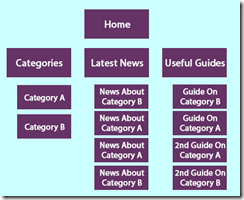Here is a little tip that I have been using for a while now when building websites that needs to rank for multiple keywords.
Everyone knows the old saying “content is king”. I always tell my customers that they need to add useful and relevant content to their website. But where do they add that content? A relatively easy way to add content is through a Latest News/Blog or maybe some useful guides on what they are selling, but how well is that content being used within the site.

Take the sitemap above. The customer has built a site around all of their categories and products and they want to rank just as well for “Category A” and “Category B” in the search engine. As well as all of their product content, they have written supporting Latest News and Useful Guide content which both helps their users and lets the search engines know their site is a resource for Categories A & B.
Spreading it about a bit…##
A common way of telling Google that the different content on your site is related is by simply linking. For example in the above example you would simply link from Category A to News About Category A and to Guide On Category A etc. This would give you a URL structure something like.
- /Category-A/
- /Latest-News/News-About-Category-A/
- /Useful-Guides/Guide-On-Category-A/
This is nothing wrong with this but I like my content a little more closely related, imagine if you had 50 categories, that would be 50 times the Latest News articles and 50 times the Useful Guides and the only thing holding it all together are a shed load of links between the sections of you site. If the search engines want to find my content on Category A then I want them to be clear when that content lives.
Content Silo##
My tip is to group the related content into silos.

This type of structure will group all of your content related to the search term you are trying to rank for and will make it clear to the search engine where your content for the search term (i.e. Category A) lives. You will still link all the content together just as you always would, but this will give you a URL structure of:
- /Category-A/
- /Category-A/Latest-News/News-About-Category-A/
- /Category-A/Useful-Guides/Guide-On-Category-A/
Now no matter how many categories you add to the site, the structure provides a clear understanding of what any new content added relates to.
Aggregate the rest##
In the above example, I would still offer a Latest News page and Useful Guide page which aggregates the content from all of the different sections of the site.
Just make sure you do not accidently offer the same content on separate URL’s and you link off to the silo URL and not create a 2nd URL structure.
When to use silos##
Like everything, it is not always a one size fits all. I find this silo structure works best when the different silos do not always relate to each other. Or to put it in terms of the example we have used.
When a user is looking for Category A they will not be interested in Category B
A more specific example could be:
When a user is looking for a restaurant in Nottingham they will not be interested in a restaurant in Derby
I hope this tip helps you when considering your next website structure. Please leave a comment on any tips you might have when structuring a site.
